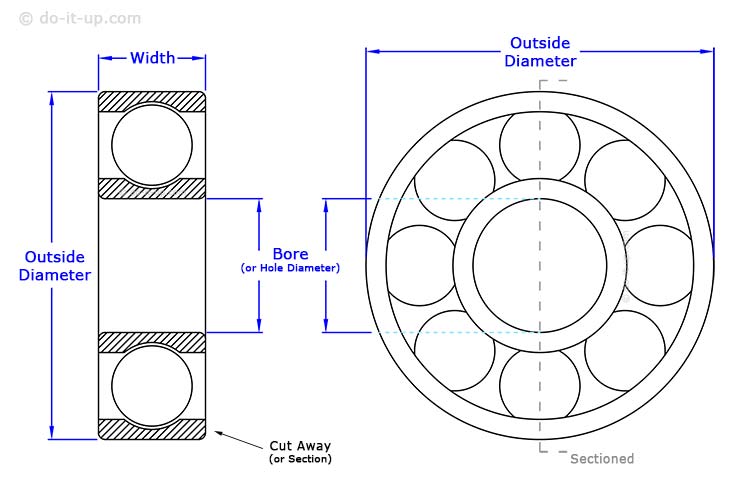How to Measure & Buy a Replacement Bearing
Many ball bearings come in standard sizes. If the item you require is just an ordinary ‘standard type’, you can measure the size, (Bore x Outside Diameter x Width), or find the size in a parts manual. With this information, you can easily buy an ‘off the shelf’ ball bearing to replace one that’s worn out.
How to Select a Bearing?
– What Measurements or Information do I Need to Buy a Bearing –
– Choosing the Right One? –
As long as it’s not some weird and wonderful, specialised type, the information below is all you need to select and buy a bearing:
Note:
Make sure you measure the bearing in the correct format. Is it a metric or an imperial (inches) bearing? You can measure in either format, but in some cases, there may be a slight difference in size (dependant on the tolerances you’re working to?).
Information Required:
Additional Info:
Measuring The Size of Bearing:
Use the following measurements, to find the size:
Bore (or hole diameter) x Outside Diameter x Width
or… Bore Ø x OD x W

The Type of Bearing:
There are generally four types…
Types of Bearing Available:
- Ball.
- Roller.
- Thrust Ball.
- Thrust Roller.
The basic requirement is to replace the bearing with the same type. Going by the names, you can generally select the correct type:
- A ball is in the shape of a ball,
- A roller is the shape of a garden roller, or a baked bean tin on its side.
- And a thrust bearing is where the load on the bearing is from the side.
The Type of Bearing Seal:
Bearings will often contain a seal to prevent the loss of lubricant and to prevent the ingress of dirt and debris. There are generally, two types of seal:
An Open Bearing:
This is where the bearing is open to the elements. It is therefore usually installed in a sealed protected environment or housing.
A Rubber Sealed Bearing:
This is where the open raceways are covered by a rubber seal to prevent the ingress of dirt and moisture.
These will have the abbreviation of: RS or 2RS
Note:
The rubber seal is generally thought to provide a better seal against ingress of dirt and moisture (compared to a steel seal).
A Steel Sealed Bearing:
This is where the open raceways are covered by a steel crimped seal to prevent the ingress of dirt and moisture.
These will have the abbreviation of: ZZ or 2ZZ
The Bearing Material:
Chromium Steel:
Chromium Steel has increased wear and corrosion resistance over plain steel.
Stainless Steel:
Stainless steel has increased wear and corrosion resistance over chromium steel (and are approximately twice the cost).
Ceramic:
Ceramics are used in the manufacture of the ball bearings. They are much harder than steel and provide high wear resistance (and are approximately four times the cost).
The Clearance:
The clearance (‘C’ rating) is the amount of play in the bearing. This sometimes needed due to heat expansion.
For precision (critical alignment) or where no great heat is generated, a ‘C’ rating is not required. E.g. a bicycle does not require a ‘C’ rated bearing.
The larger the number, the bigger the clearance: C3, C4, C5.
What’s Lubricant is the Bearing Filled With:
This isn’t always stated, (and you may have a personal preference?). But it’s always worth trying to determine whether oil or grease was used as the original lubrication in the bearing when new.
- Oil.
- Grease.
- Nothing?
Why Should I buy a Bearing Direct from a Supplier?
There are various types, and they come in a multitude of shapes and sizes. When you buy a bearing, sometimes it’s easier just to specify “I want a bearing for a widget machine” and the jobs done. But is it actually the easiest route to buying a bearing?
Positives (buying from the widget machine supplier):
- If it’s for a high-end product, where safety is involved, or there is a high cost for machinery downtime. It is best to get the OEM (or widget machinery suppliers) bearing for peace of mind.
- You don’t have to measure the actual size (Bore x Outside Diameter x Width), or find the size in a manual.
Negatives (buying from the widget machine supplier):
- Additional cost – If you buy from the original equipment supplier, there are added markup costs (in many cases, they will also buy in their bearing stock from an external supplier).
- The OEM supplier may be nowhere near you, if you need a bearing in a hurry.
“Buying direct, cutting out the middle man will always be because of cost or the speed of supply”. I would guess that 99.9% of manufacturer’s that use bearings, buy-in their stock.
Therefore, why not go directly to a bearing wholesaler (see the positives and negatives above), rather than to an original equipment supplier (who buys in their bearings)?